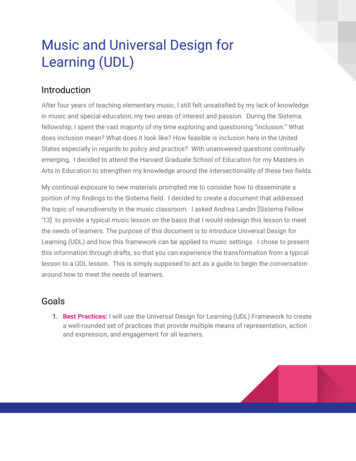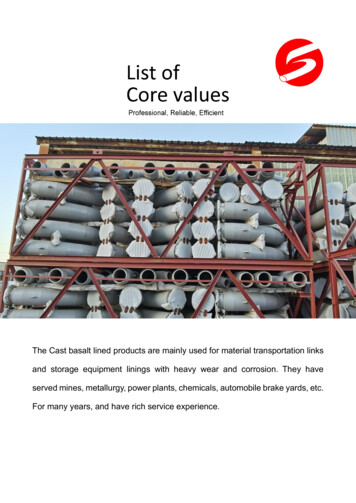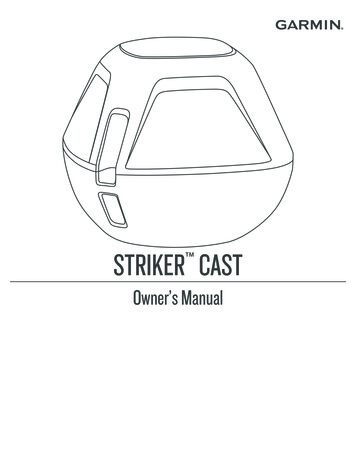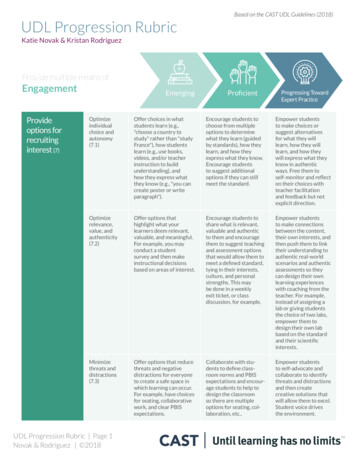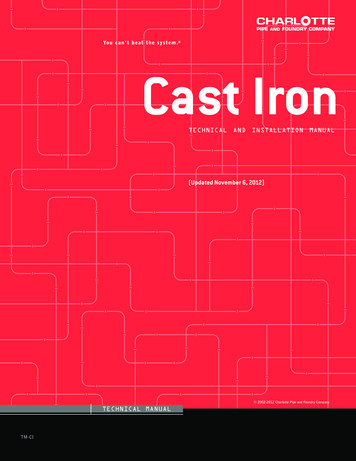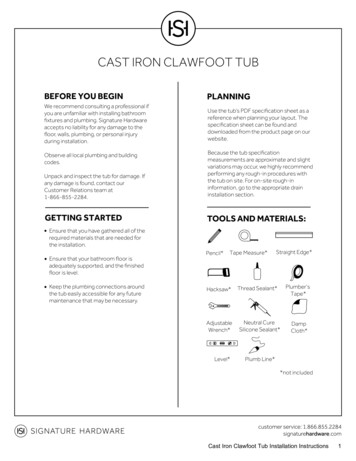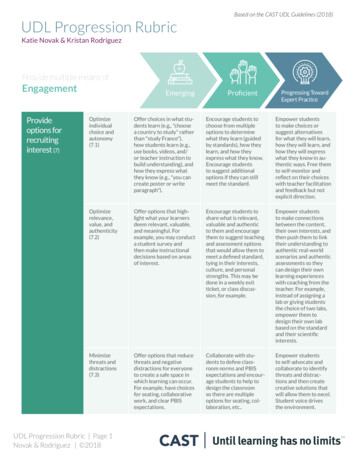
Transcription
Based on the CAST UDL Guidelines (2018)UDL Progression RubricKatie Novak & Kristan RodriguezProvide multiple means ofEngagementProvideoptions forrecruitinginterest (7)EmergingProficientProgressing TowardExpert PracticeOptimizeindividualchoice andautonomy(7.1)Offer choices in what students learn (e.g., "choosea country to study" ratherthan "study France"),how students learn (e.g.,use books, videos, and/or teacher instruction tobuild understanding), andhow they express whatthey know (e.g., "you cancreate poster or writeparagraph").Encourage students tochoose from multipleoptions to determinewhat they learn (guidedby standards), how theylearn, and how theyexpress what they know.Encourage studentsto suggest additionaloptions if they can stillmeet the standard.Empower studentsto make choices orsuggest alternativesfor what they will learn,how they will learn, andhow they will expresswhat they know in authentic ways. Free themto self-monitor andreflect on their choiceswith teacher facilitationand feedback but notexplicit direction.Optimizerelevance,value, andauthenticity(7.2)Offer options that highlight what your learnersdeem relevant, valuable,and meaningful. Forexample, you may conducta student survey andthen make instructionaldecisions based on areasof interest.Encourage students toshare what is relevant,valuable and authenticto them and encouragethem to suggest teachingand assessment optionsthat would allow them tomeet a defined standard,tying in their interests,culture, and personalstrengths. This may bedone in a weekly exitticket, or class discussion, for example.Empower studentsto make connectionsbetween the content,their own interests, andthen push them to linktheir understanding toauthentic real-worldscenarios and authenticassessments so theycan design their ownlearning experienceswith coaching from theteacher. For example,instead of assigning alab or giving studentsthe choice of two labs,empower them todesign their own labbased on the standardand their scientificinterests.Minimizethreats anddistractions(7.3)Offer options that reducethreats and negativedistractions for everyoneto create a safe space inwhich learning can occur.For example, have choicesfor seating, collaborativework, and clear PBISexpectations.Collaborate with students to define classroom norms and PBISexpectations and encourage students to help todesign the classroomso there are multipleoptions for seating, collaboration, etc.Empower studentsto self-advocate andcollaborate to identifythreats and distractions and then createcreative solutions thatwill allow them to excel.Student voice drivesthe environment.UDL Progression Rubric Page 1Novak & Rodriguez 2018
Provide multiple means ofEngagementProvide optionsfor sustainingeffort andpersistence (8)EmergingHeightensalience ofgoals andobjectives(8.1)Vary demandsand resourcesto ity(8.3)Increasemasteryorientedfeedback(8.4)UDL Progression Rubric Page 2Novak & Rodriguez 2018ProficientProgressingToward ExpertPracticeBuild in “reminders”of both goals and theirvalue. For example, writestandards on the boardand/or at the top of assessments and projects.Encourage students tocollaboratively discussgoals in light of students' own passions andinterests and to choosefrom various options toreach the goals.When given the learning standard, have students create personalgoals for how theywill learn the content,express the content,and challenge themselves throughout theprocess.Provide options forstudents to learn contentwith clear degrees ofdifficulty. For example,"Explore one of the following resources to learnabout the Civil War." andthere may be a rigorousprimary source document and a video.Provide multiple optionsfor students to learncontent with clear degrees of difficulty whichwill require them toreflect on the standardand their own strategyfor learning. For example, "Choose two of thefollowing six resourcesto learn about the CivilWar." and there may berigorous primary sourcedocuments, summarydocuments, videos, and/or a podcasts from aprofessor.Empower studentsto select their owncontent and/or ownassessments, basedon standards, andencourage them tocollaborate to add tothe multiple optionsoffered to challengethemselves and identify appropriate resources that connect to theirinterests and passions.Provide opportunitiesfor students to learn howto work effectively withothers. For example, create cooperative learninggroups with clear goals,roles, and responsibilities.Develop a classroomthat values collaborativegroupwork. Studentsconstruct their owngroups and create theirown group norms,responsibilities, etc. andstudents often seek outand work with diversepartners.Create a classroomculture where students work togetherto define goals, createstrategies, providefeedback to each otherand push each otherwith mastery-oriented feedback whilebuilding integrativethinking.Provide feedback thatguides learners towardmastery rather than afixed notion of performance or compliance. Forexample, provide feedback that encourages theuse of specific supportsand strategies in the faceof challenge.In addition to providingemerging feedback,empower students toprovide mastery-oriented feedback toeach other to supportspecific improvementand increased effort andpersistence.Implement proficientpractice and alsoempower students touse mastery-orientedfeedback independently to self-reflect,self-direct, and pursuepersonal growth inareas of challenge.
Provide multiple means ofEmergingEngagementProvide optionsfor selfregulation (9)Promoteexpectationsand beliefsthat optimizemotivation(9.1)Facilitatepersonalcoping skillsand strategies(9.2)Develop selfassessmentand reflection(9.3)UDL Progression Rubric Page 3Novak & Rodriguez 2018ProficientProgressingToward ExpertPracticeTeach students aboutthe power of perseverance and use languageand feedback that willallow all students to seethemselves as capablelearners.Foster conversationswith students to develop relationships andmake authentic connections and use theirpersonal passions andinterests to help inspirethem and push themtoward success.Create a classroomculture where studentsare empowered andable to support theirown self-talk andsupport one another'spositive attitudestoward learning.Offer reminders, models, and tools, to assistlearners in managing anddirecting their emotionalresponses. For example,use stories or simulationsto demonstrate copingskills. Offer optionsfor stress release suchas alternate seating,fidget tools, mindfulnessbreaks, etc.Empower studentsto deal with difficultchallenges by allowingthem to choose frommultiple strategies toregulate their learning(e.g., a relaxation corner,put on headphones, takea walk).Encourage students toself-reflect, accuratelyinterpret their feelings,and use appropriatecoping strategies andskills to foster learningfor themselves andtheir classmates.Provide students withtools so they are reflecting on their learningthrough rubrics, self-assessment, etc.Offer multiple modelsand scaffolds of different self-assessmenttechniques so studentscan identify and chooseones that are optimal.For example, thesemight include ways tocollect, measure, anddisplay data from theirown behavior and academic performance forthe purpose of monitoring growth.Create a culture wherestudents consistentlyreflect on the learningprocess and assessments so they becomeself-directed learnerswho grow over time.
Provide multiple means ofRepresentationProvideoptions forperception (1)Offer ways ofcustomizingthe display ofinformation(1.1)Offeralternativesfor auditoryinformation(1.2)Offeralternativesfor visualinformation(1.3)UDL Progression Rubric Page 4Novak & Rodriguez 2018EmergingProficientProgressingToward ExpertPracticeCreate resources andmaterials that addressvariability and meet theneeds of more students(e.g., large size print,additional white space,visuals).Create resources andmaterials that studentscan access electronically. Allow studentsto use their devicesto interact with textual, visual and audioinformation so they canpersonalize, take notes,increase/decrease size/volume, etc.Empower studentsto choose resourcesand materials thatbest meet their needs(e.g., watch a video ORexplore a handout)so they can personalize their learningthemselves withoutexplicit direction froma teacher.Provide an embeddedoption for any information presented aurally. For example, useclosed-captions whenplaying a video.Provide multipleoptions for students tochoose alternatives tolearn content so theydon't have to rely onauditory information(e.g., closed captions forvideo or the choice ofreading a text).Empower studentsto select auditoryalternatives as well asprovide them with aframework to locateadditional, reputableresources to buildtheir understanding(e.g., resources onhow to determine if awebsite or author iscredible).Provide an embeddedoption for students sothey don't have to relyon visual information.For example, readingaloud to the class whilethey read along.Provide multipleoptions for students tochoose alternatives tolearn content so theydon't have to rely onvisual information (e.g.,listen to audiobookinstead of reading orchoose to work withteacher for short presentation).Empower students toselect alternatives tovisual information aswell as provide themwith a frameworkto locate additional,reputable resourcesto build their understanding (e.g.,resources on how todetermine if a websiteor author is credible).
Provide multiple means ofRepresentationProvideoptions forlanguage,mathematicalexpressions,and symbols (2)Clarifyvocabularyand symbols(2.1)Clarify syntaxand structure(2.2)Supportdecodingof text,mathematicalnotation, andsymbols(2.3)Promoteunderstanding (2.5)UDL Progression Rubric Page 5Novak & Rodriguez 2018EmergingProficientProgressingToward ExpertPracticeTranslate idioms, archaicexpressions, culturallyexclusive phrases, andslang. For example, explicitly teach vocabularyto students using definitions, visuals, explanations, and examples.In addition to emerging practice, providestudents with explicitinstruction in contextclues so they can independently learn wordsunfamiliar to them.Empower students touse available resourcesto work collaborativelyto determine authenticways to use relevantvocabulary.Clarify unfamiliar syntax(in language or in mathformulas) or underlyingstructure (in diagrams,graphs, illustrations,extended expositions ornarratives). For example,highlight the transitionwords in an essay.Provide students withresources that will allowthey themselves to clarify syntax and structure(such as dictionaries,math reference sheets,thesaurus, etc.)Empower studentsto preview materialunder study, highlightareas in need of clarification, and chooseappropriate resourcesto build knowledge andunderstanding.Provide direct instruction, prompts, andscaffolded materials forstudents who struggle tocomprehend information.Or provide alternatives,such as visuals, to support this understanding.Provide strategies andmaterials (e.g., mathreference sheets,context clue strategies,and so forth) that lowerbarriers to understandand help students figureout notations, symbols,or problems.Empower students toindependently utilizelearned strategies todecode text, mathematical notation, andsymbols.Provide alternativepresentations of material, especially for keyinformation or vocabulary. For example, makekey information in thedominant language (e.g.,English) also availablein the first languages oflearners with limited-English proficiency. Also,use images AND words,show opposites, etc.Provide students withaccess to tools suchas apps, websites, anddictionaries to translatematerial under studyand to collaborativelybuild understanding.Empower students toindependently utilizeoptions to translatematerial under study,collaborate to buildunderstanding usingtools, apps, etc.Present key conceptsin one form of symbolicrepresentation (e.g.,an expository text or amath equation) with analternative form (e.g.,an illustration, diagram,video, etc.)Present students withmultiple options andsymbolic representations to make meaningand allow them tochoose options to buildcomprehension.Empower students tochoose effective resources from multipleoptions with multiplerepresentations sonot all students arerequired to learn fromthe same resources.
Provide multiple means ofRepresentationProvideoptions forcomprehension(3)Activateor iticalfeatures, bigideas, sualization,andmanipulation(3.3)Maximizetransfer andgeneralization(3.4)UDL Progression Rubric Page 6Novak & Rodriguez 2018EmergingProficientProgressingToward ExpertPracticeProvide all students withbackground informationon content using directinstruction with optionsfor visuals, audio, etc.Provide students withoptions that supply oractivate relevant priorknowledge, or link to theprerequisite informationelsewhere. For example,use advanced organizers (e.g., KWL methods,concept maps) and thenencourage students toselect resources thatwill allow them to buildappropriate backgroundknowledge.Empower studentsto determine gaps intheir own backgroundknowledge and thenselect appropriateresources to build thatknowledge in order toachieve the goals of alesson. For example,begin with a diagnosticassessment and askstudents to reflectand create a strategyfor filling in gaps inlearning.Provide explicit cues orprompts to help studentsrecognize the mostimportant features ininformation. For example,teach students to useoutlines, graphic organizers, highlighters, etc.Provide students withoptions and multiplestrategies to supportrecognition of the mostimportant features in information. For example,allow them to use outlines, graphic organizer,highlighter, word cloudapps, and other organizing tools.Empower studentsto self-reflect todetermine the mosteffective strategiesfor highlighting criticalinformation and independently select thestrategies that allowthem to support recognition of patterns, critical features, big ideas,and relationships.Provide all students withmaterials, strategies, andtools to support processing and visualization.Tools include manipulatives (i.e, counting cubes),glossaries, graphic organizers, and more.Provide students withoptions of multiplematerials, strategies,and tools to use tosupport processing andvisualization, such as theoption to make visualnotes, use technologyto locate images, and/orselect and use manipulatives, etc.Empower studentsto self-reflect andindependently choosethe most appropriatematerials, strategies,and tools to guide information processing,visualization, and manipulation, searchingfor additional tools andstrategies, if necessary.Model explicit strategiesstudents can use to transfer the information theyhave to other contentareas and situations. Forexample, show how theknowledge could be usedin another class or beused to make comparisons across content inthe class (such as text totext comparisons).Provide options formeaningful transfer,such as interdisciplinary projects, wherestudents can makeauthentic connectionsand apply knowledgein meaningful ways inother content areas andin authentic situations.Encourage studentsto apply knowledgeand skills learned inclass to enhance theirunderstanding ofcontent, design of theirown authentic projects, and express theirknowledge and understanding in authentic,real-world scenarios.
Provide multiple means ofAction & ExpressionProvideoptions forphysicalaction (4)Provideoptions forexpressionandcommunication (5)EmergingProficientProgressingToward ExpertPracticeVary themethods forresponse andnavigation(4.1)Provide more than one optionfor the methods used forresponse and navigation withinthe same assignment. Forexample, some students mayuse IPads while others write byhand.Provide multiple options forthe methods used for responseand navigation within the sameassignment. For example, somestudents may use IPads, different writing utensils, keyboards,voice recognition software, etc.Empower students to usetheir own devices to respondto and interact with materials for all assignments (e.g.,options to use headphones,keyboards, manipulatives,joysticks, etc.).Optimizeaccess to toolsand assistivetechnologies(4.2)Allow some students to useassistive technologies fornavigation, interaction, andcomposition if required by anIEP or 504.Provide multiple options forall students to use assistivetechnology like IPads, voicerecognition, and 1:1 devicesregardless of variability.Empower students to assessthe need for and choosetechnologies that work forthem to provide additional,personalized options toexpress their knowledge andskills.Use multiplemedia forcommunication(5.1)Provide more than one wayto answer on assessments sostudents can express theirunderstanding without barriers.Taking a traditional test may beone option, but so, too, could bean oral presentation or writingan essay.Provide students with multiple options to express theirunderstanding--and let themsuggest some ways of being assessed, so they understand thatshowing what they know is thepoint rather than how well theyperform on a particular kind oftest. Students may choose toexpress their understanding intext, audio, video, multimedia,live presentations, and manyother ways.Let students reflect on astandard or a set of competency or proficiency-basedrubrics, and then independently create authenticand innovative products thatallow them to demonstratetheir mastery of the standard.Use multipletools forconstructionandcomposition(5.2)Provide the choice of more thanone tool or strategy to help students express their knowledge.For example, allow students tocompose a response using traditional pen and paper or allowthem to create a multimediapresentation on their device.Provide multiple tools andstrategies to help studentsexpress their knowledge. Forexample, allow students tocompose a response usingtraditional written methods,blogging software, or multimedia tools such as ThingLink orEmaze.When provided with a task,or when independently creating an authentic product,students are empoweredto self-reflect and selecttools and materials that willsupport their learning andchallenge them to strive forrigorous options to expressknowledge and skills inaccessible, engaging ways using, and then building upon,the tools they were exposedto in class.Build fluencieswith graduatedlevels ofsupport forpractice andperformance(5.3)Implement a scaffolding modelfrom teacher-directed to collaborative groups to independent work, slowly releasingresponsibility to students.For example, in collaborativework, assign team membersspecific tasks and monitor theirprogress before moving to independent work or move fromteacher-directed instruction toSocratic seminars.Provide options for supportand scaffolding throughoutthe learning process andencourage students to chooseresources that allow them tobuild their own knowledgewhile working in collaborativegroups and working independently. In collaborativegroups, for example, encouragestudents to self-select roles; inclass discussions, have studentscollaborate to design the rulesand structures.Empower students to createchallenges that let them productively struggle to reachrigorous goals and use supports as tools to help them tomake improvements ratherthan making things "easier." Encourage students toprovide feedback and driveteacher instruction; encourage them to define roles andexpectations for group workthat include routine monitoring and reflection.UDL Progression Rubric Page 7Novak & Rodriguez 2018
Provide multiple means ofAction & ExpressionProvideoptions forexecutivefunctions (6)EmergingProficientProgressingToward vide clear goals to students so it's clear what theymust do to meet or exceedexpectations. For example,post standards on the boardand on assignments, andarticulate those standardsand goals throughout thelesson.Create conditions for learners to develop goal-settingskills. For example, providestudents with standards onthe board and on assignments, but also providemodels or examples of theprocess and product ofgoal setting so all studentscan develop personalizedgoals while working towardstandards.Encourage studentsto create personalizedlearning plans thatinclude goals that alignto identified standardsas well as action plansand strategies thatoptimize personalstrengths while addressing individualizedareas of challenge.Supportplanningand strategydevelopment(6.2)Facilitate the process ofstrategic planning. For example, provide all studentswith checklists for tasks,due dates, and planningtemplates to keep studentsorganized.Facilitate the process ofstrategic planning. Forexample, provide studentsnot only with organizationaltools but with scaffolds theyneed to create personalizedstrategies to meet theirgoals.Empower students toself-reflect, self-assess,and create personalized action plans toachieve their identifiedgoals. For example,encourage students toreflect on how muchtime and resourcesthey need to performselected tasks andthen encourage themto make personal duedates and task lists toreach their goals.Facilitatemanaginginformation andresources(6.3)Provide scaffolds andsupports to act as organizational aids for students.For example, provide allstudents with templates fornote-taking.Provide exposure to multiple scaffolds, supports,and resources that act asorganization aids, such as avariety of graphic organizersor different strategies fornote-taking.Empower students toself-reflect, self-assess,and independentlychoose the mostappropriate supportsand resources that willallow them to organization information andresources so they canachieve their identifiedgoal(s).Enhancecapacity formonitoringprogress(6.4)Provide formative feedbacktools to students so theycan monitor their own progress. For example, providestudents with assessmentchecklists, scoring rubrics,and multiple examples ofannotated student work/performance examples.Provide multiple opportunities for students to receivefeedback from the teacher,peers, and themselves usinga variety of tools such as assessment checklists, scoringrubrics, and exemplars.Empower students touse multiple resources,including teachers andpeers, to consistentlyreflect on their performance, collect feedback, and revise theirwork to promote andhighlight growth.UDL Progression Rubric Page 8Novak & Rodriguez 2018
design the classroom so there are multiple options for seating, col-laboration, etc. Empower students to self-advocate and collaborate to identify threats and distrac-tions and then create creative solutions that will allow them to excel. Student voice drives the environment. Provide multiple means of Engagement UDL Progression Rubric



